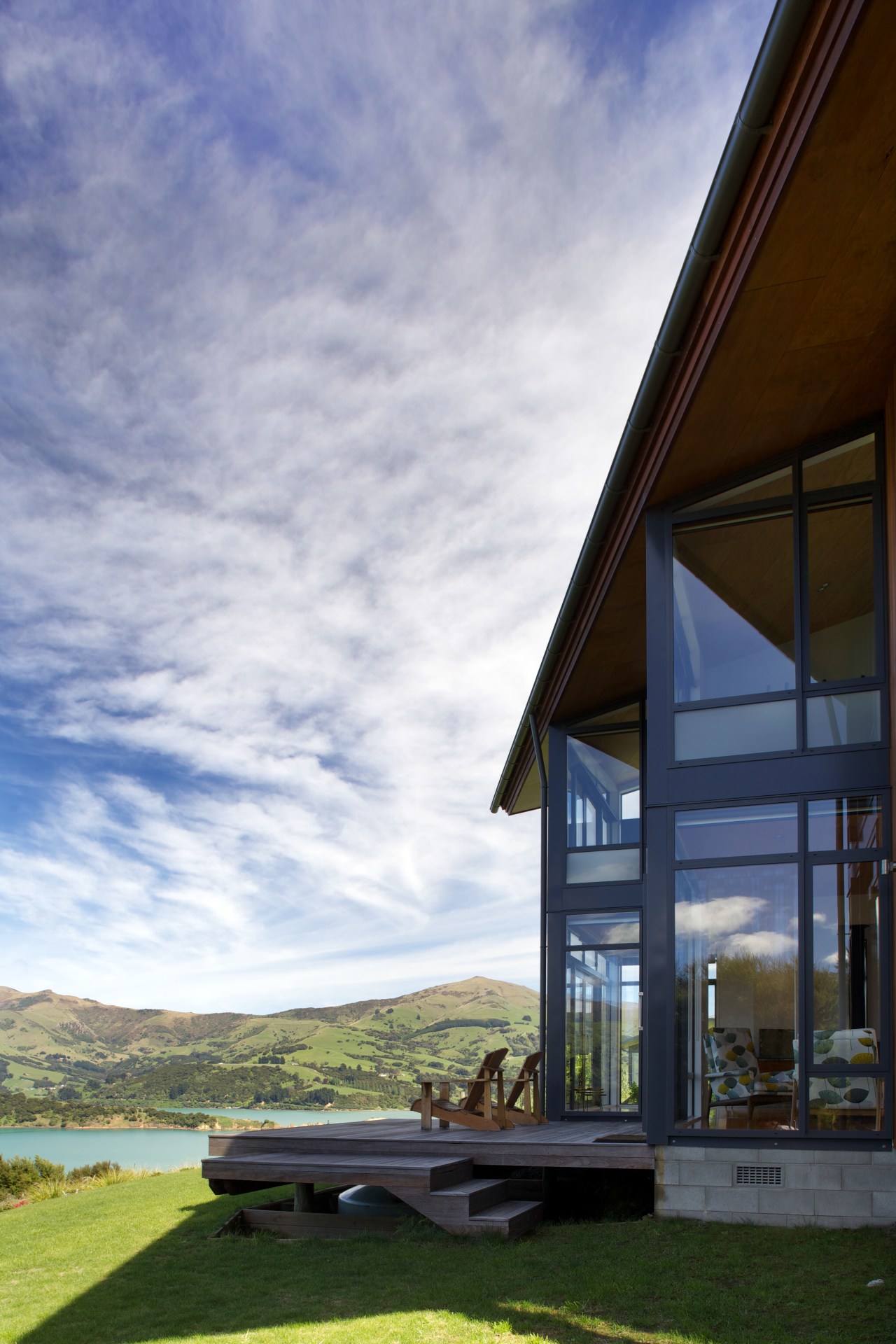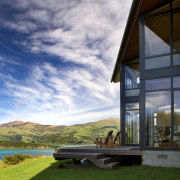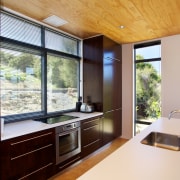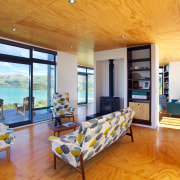Hill-top holiday home
Modern holiday home with cedar cladding, stepped exterior, glazed modules, twisted pitched roof, Mid-century Modern interior

Escaping the city for a holiday home on the coast involves a complete change of lifestyle. The days take on their own shape as the family settles into a lazy routine that may or may not involve entertaining, boating, swimming or hiking. Either way, it will certainly be all about relaxation.
Holiday homes need to encourage such a lifestyle. It helps if they are low maintenance, and they work best when there's a social hub where everyone can hang out together, and enjoy the views and sunshine. And, for most families, a holiday home needs to be designed and built in a cost-effective manner.
All these elements came into play with this Akaroa house, designed by David Hill of Wilson and Hill Architect and built by James Mackay Builders.
Hill says the owners wanted their holiday home to be informal, and built from simple materials. The architect says it was also important to minimise the footprint, even though the site is large.
"A Coastal Protection Zone boundary runs right through the site, which limited where we could build. The owners also wanted the house to be at the top of the site, which would provide the easiest access and the best views. As a result, the actual building platform was quite small, so the footprint of the house is not large."
To maximise the spectacular views, Hill created a series of three glazed, double-height modules that step back along the ridge. These are capped with a twisted, pitched roof that follows the angle of the building, creating a sheltering overhang between each module.
"The house has quite a simple form, with the double storey helping to minimise the footprint," the architect says. "The stepped modules break up the mass of the building on the south side. And the design provides glazed corners that open up the interior to the view and the morning sun the view is much more expansive than it would have been without these."
Hill indented the two ends of the house, so they form a V shape that also helps to break up the mass, visually. In addition, the V creates bay window areas and alcoves that the owners can decorate and furnish as more intimate spaces.
The front door opens directly into the large, open-plan family living area and kitchen, which in turn lead to a living area. Because this level is essentially one room deep, it benefits from both the sun coming in through full-height windows on the north side, and the views through the floor-to-ceiling glazing to the south.
"The property is quite far from the city, so we tried to limit the number of trades we had working on site," says Hill. "Wherever possible, we ensured finishes and services could be provided by the building company that was already on site. For example, there is no ceramic tiling anywhere in the house. For this reason also, the entire floor features stained pinus radiata plywood, and this is replicated in the ceilings. Together these surfaces provide a lot of visual warmth."
To differentiate the kitchen joinery, the cabinetry, which is also plywood, was stained in a dark brown shade. This helps to anchor the kitchen in the overall space.
"It's a very simple little kitchen, designed on symmetrical lines, with a long island-style peninsula providing plenty of bench space for food preparation and serving," says Hill.

Built-in shelving units in both the family room and the living area also feature dark-stained plywood, which makes a strong contrast to the white walls behind. And the raised hearth is clad in black stone slabs. Bright colour accents of teal blue and yellow appear in the upholstered furniture and cushions.
A plywood staircase leads to three bedrooms on the upper level a master suite at one end, and two bunkrooms. Obscure glass panels wrap around the bottom of windows on this floor, providing privacy, yet not obstructing the views the bathtub in the master suite has one of the best views.
The bathroom floors are lined with a textural, orange vinyl tile chosen by the client. This introduces a welcome punch of colour to the otherwise neutral palette.
As with any holiday home, much of the living happens outdoors. Large sliding stacker doors open up the family and living rooms to a timber deck that is cantilevered out from the hill towards the view. But this side of the house is also exposed to the worst of the southerly storms that can hit the bay.
"To provide a more sheltered spot, we introduced a courtyard on the northeast side of the house," says Hill. "This is dug into the ground a little, for added protection from the wind."
Story by: Trendsideas
Home kitchen bathroom commercial design
Home Trends Vol. 30/4
New Home Trends features top locations from New Zealand and the rest of the world. New Home Trends is dedicated to provi...
Read More













